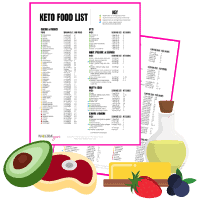
Free Printable: Low Carb & Keto Food List
Get It Now- What Is A Low Carb Diet Plan?
- What Is The Keto Diet?
- Keto Diet Rules: How To Start Keto
- Get The Printable Keto Cheat Sheet System
- Understanding & Counting Macros
- What To Eat On A Keto Diet
- Low Carb & Keto Recipes
- Keto Meal Plans
- Keto Diet Benefits
- Keto Diet Side Effects
- Common Questions
- Conclusion: Is The Keto Diet For You?
- Recipe Reviews
Welcome to the ultimate guide to the keto diet plan, a form of low carb diet. If you are new to Wholesome Yum, or just starting out with this lifestyle, you’ve come to the right place. This guide will show you everything you need to know about how to start a keto diet, including keto diet basics, how to understand and calculate macros, what foods to eat, recipes to make, how to avoid side effects, and more. Be sure to check out all the keto diet recipes and the keto diet app, too!
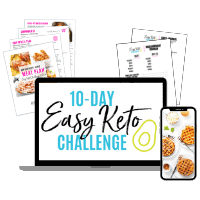
JOIN THE EASY KETO CHALLENGE!
Join 300,000+ others to get this free guide to kickstart keto (everything you need to know, broken up into 10 doable days!) and get support.
JOIN THE CHALLENGEWhat Is A Low Carb Diet Plan?
A low carb diet plan is a way of eating that is high in fat, moderate in protein and low in carbohydrates. It ends the rollercoaster of blood sugar spikes and crashes, allowing the body to burn fat.
There are different variations of low carbohydrate diets. The keto diet plan is a special type of low carb diet, with added characteristics. Optimal carb intake will vary depending on your insulin tolerance and activity level, but on average, these are the common numbers of carbs:
- Keto diet – Under 20g net carbs per day (sometimes under 25g or 30g works)
- Low carb diet – Under 50g net carbs per day
- Moderate low carb diet – Under 100g net carbs per day
Some people opt to count carbs diligently and some choose to simply focus on eat low carb or keto foods. For comparison, according to the Dietary Guidelines For Americans, a Standard American diet contains between 225 and 325 grams of carbohydrates per day.
What Is The Keto Diet?
The ketogenic diet, or keto diet plan, is a specific type of low carb diet that is focused on a specific ratio of macronutrients (or macros for short — these include fat, protein, and carbohydrates), with a goal of reaching a state called ketosis.
There are different ways to follow this diet, including clean keto (focusing on whole foods and nutrients), dirty keto, and lazy keto, among others, but ketosis is the goal with all of them. The keto diet basics below apply to all of them, as well.
What Is Ketosis?
Ketosis is a metabolic state in which the body burns fat for fuel instead of carbs. It’s very effective for weight loss, energy, and mental clarity [*, *, *, *]. The body enters a ketogenic state when carbs are restricted for extended periods, through a low carb diet, fasting [*], or starvation [*].
How Does The Keto Diet Work?
Unlike a low carb diet, ketosis is the primary goal of the keto diet plan. We achieve it by severely limiting carbohydrate intake, not necessarily calories, though calories are often restricted as a byproduct.
The core of how the keto diet works boils down to two things:
- In the absence of carbohydrates, the body switches to burning fat for fuel instead of glucose. When carbs are restricted and your body runs out of glucose, your body turns to fat in food and fat stores for fuel instead. Your livers breaks down the fat into ketones, small energy molecules that your body can use for energy [*].
- A ketogenic diet keeps insulin levels low. Insulin is a signal for your body to hold onto its fat stores, so low levels help your body access its fat stores for energy [*]. This regulates your blood sugar levels as well.
Signs of ketosis include increased energy and focus, decreased appetite, and changes in smell of breath or urine. You can test yourself for ketosis using ketone test strips (use code WHOLESOME for 15% off!). A blood monitor is the most accurate, but not usually necessary if you follow the keto diet rules.
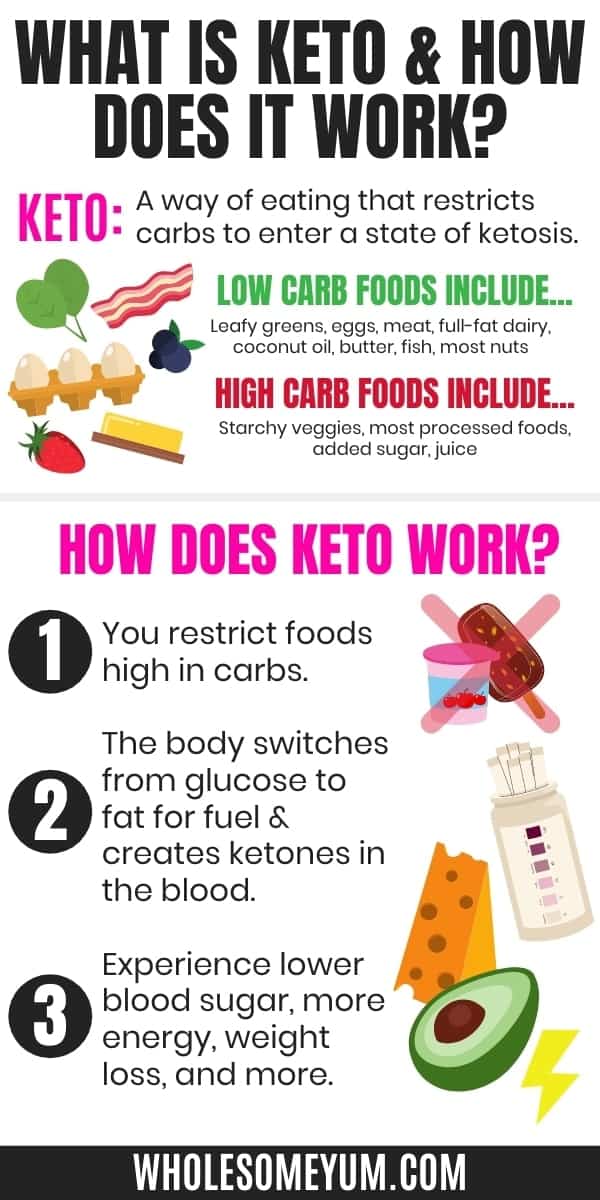
Keto Diet Rules: How To Start Keto
If you want to start a keto diet or low carb diet plan, it can be intimidating. I get it! I’ve been doing this for almost a decade (and it goes to show this is a sustainable lifestyle!), but it wasn’t always easy. We all have to start somewhere. Just start — you got this!
Whether you’re looking for how to start a keto diet or a low carb diet, there are lots of similarities. Let’s make it as easy as possible…
Easy Steps For Starting A Keto Diet
The main point to remember when starting a keto diet is this:
RULE #1: Restrict Carbohydrates. This is the most crucial part! Restrict to less than 20g or 25g net carbs per day for a keto diet plan (some people can get away with under 30g).
For a low carb diet, aim for under 50g net carbs per day. Some variations limit to somewhere between 50-100g per day, particularly if you are more active.
Stay below your carb limit and you’re most of the way there! But to ensure your success, here are some additional tips for getting started on a keto diet — and the same applies for a low carb diet as well:
- Limit protein intake. Contrary to popular belief, keto diets and low carb diets are not high protein diets! Low carb is generally higher in protein than keto, but be careful with both. High protein diets can stress the kidneys, and besides, excess protein converts to glucose. Make your protein intake a goal to meet each day, but more than that is not better.
- Use fat as a lever. We’ve been taught to fear fat, but don’t! Both keto and low carb are forms of a high-fat diet. Fat is our source of energy as well as satiety. The key to understand, though, is that fat is a lever on a low carb or keto diet. Carbs and protein stay constant, and fat is the one you increase or decrease (push the lever up or down) to gain or lose weight, respectively. So if your goal is weight loss, eat enough fat to be satisfied, but there’s no need to “get your fats in” once you’re satisfied.
- Drink lots of water. This is especially crucial on a low carb or keto diet. Why? When you eat carbs, your body stores the extra as glycogen in the liver, where they are bound to water molecules. Eating low carb depletes this glycogen, which allows you to burn fat. But it also means you are storing less water, making it easier to get dehydrated. Instead of the traditional recommendation of 8 cups of water per day, aim for 16 cups when following a low carb lifestyle.
- Keep up electrolytes. The major electrolytes in our bodies are sodium, potassium and magnesium. It’s crucial to get enough of these so that you don’t experience these side effects — they are temporary, but avoidable. Read more about side effects and their remedies below.
- Eat only when you are hungry. Get out of the mindset that you need to eat 4-6 meals per day or constantly snack. Eating too frequently on a keto or low carb diet is not necessary, and can affect weight loss. Eat when you’re hungry, but if you aren’t, don’t. Eating fewer carbs will make this much easier, as this naturally suppresses appetite.
- Focus on whole foods. Although eating natural or whole foods is technically not 100% required to restrict carbohydrates, eating processed foods will not help you get rid of cravings or be good for your body. Check the section below for more on what low carb foods are best.
- Exercise. This is not required for a low carb diet, but recommended. You’ll feel better, improve your health, and if your goal is weight loss, it will happen faster!
Keto Diet Tips For Beginners
The steps above are the most important, but to set yourself up for success, read over these keto diet tips for beginners, too.
Get The Printable Keto Cheat Sheet System
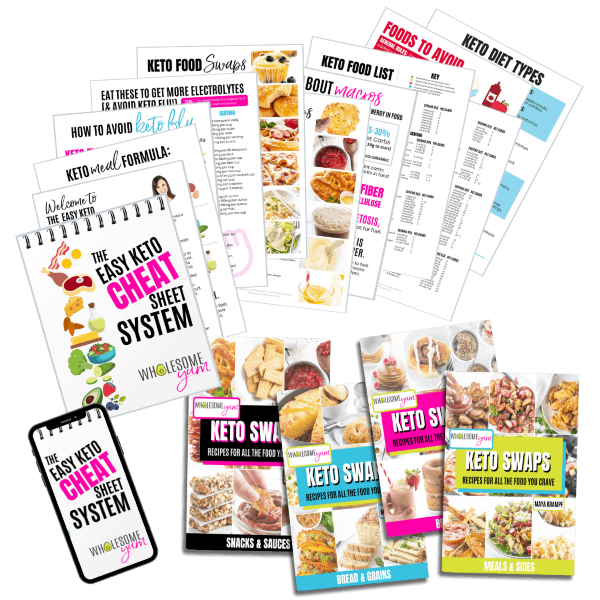
Get all this information and MORE in convenient printer-friendly format - 13 cheat sheet pages you can take with you anywhere or keep in your kitchen, plus 4 recipe cookbooks! Includes:
- Keto food list (230+ foods) - Super detailed & color-coded, with net carb counts, so you'll know exactly what to eat.
- Foods to avoid on keto - Detailed and specific list so that you know exactly what to watch out for.
- Macros cheat sheet - Explains everything you need to know about macros to succeed on keto.
- Keto food swaps (60+ foods) - Covers virtually every food you love, so you don't have to miss out!
- Keto meal formula - With specific food ideas, so it's easy to mix-and-match.
- Keto flu guide - Understand what it is and exactly how to avoid it.
- Electrolyte cheat sheet - With whole food ideas + bonus keto tips.
- Keto Diet Types - Summary of 4 ways to do keto, so you can choose what fits you best.
- FOUR (4!) Keto Swaps Recipe EBooks - Dozens of recipes to replace bread, rice, potatoes, pasta, desserts, and other carbs you'd otherwise miss.
Get The Printable Keto Cheat Sheet System + 4 EBooks (Only $37)
Understanding & Counting Macros
What are macros? Simply put, “macros” is a shortened name for macronutrients, which provide energy and come in the form of fat, protein, and carbohydrates.
All three play a role in a successful keto diet plan:
- Fat – Fat acts as the primary fuel source on a keto diet, unlike a standard diet where carbohydrates are the main source. Your are in ketosis when your body has made the metabolic switch to using fat for most of its energy. In addition, it keeps you satisfied. Just keep in mind that you burn the fat from your food before burning body fat, so use fat as a lever to lose weight, maintain, or gain muscle depending on your goals. Aside from energy, fat plays an important role in metabolism, immune function, reproduction, and absorption of vitamins [*].
- Protein – Proteins are made up of amino acids, which are commonly referred to as the building blocks in our bodies. Proteins are crucial for the structure, function, and regulation of tissues and organs, including antibodies, enzymes, messengers, structural support for cells, transport, and muscle preservation [*]. On a ketogenic diet, you want to get enough protein to support all these functions. However, if you get too much protein, the excess will be converted into glucose by the body — this process is called gluconeogenesis and we want to keep it to a minimum.
- Carbohydrates – Carbs are the most crucial piece of the puzzle. In fact, restricting carbohydrate intake is technically the only thing necessary to enter a state of ketosis. While it’s commonly cited that the brain needs glucose to function, the brain is able to get most of its needed energy from ketones and the liver can make up the rest via gluconeogenesis [*, *]. When we talk about low carbohydrate intake on a keto diet, we usually refer to net carbs, explained below.
As a general guideline, below are the recommended macro percentages to aim for. These are the percentages of your total calorie intake that would be from fat, protein, and carbs.
Macros For A Low Carb Diet Plan:
- Fat: 40% to 70%
- Protein: 15 to 30%
- Net Carbs: 15% to 30%
Macros For A Keto Diet Plan:
- Fat: 60% to 75%
- Protein: 20% to 25%
- Net Carbs: 5% to 10%
You can learn more about how macros work here.
What Are Net Carbs?
Net carbs are the carbohydrates that your body is able to digest and break down into glucose for energy.
The carbohydrates in fiber and non-digestible keto sweeteners, like erythritol and allulose, have zero net carbohydrates, because we are not able to extract that energy. (Read more about sugar substitutes here and you can use the sweetener conversion chart to swap sweeteners.)
TIP: To determine net carbs in any food, subtract the fiber, sugar alcohols (like erythritol), and allulose from the total carbs. Make it easy by using the net carb calculator, where you can also learn more about how net carbs work.
Should You Count Total Carbs Or Net Carbs?
Some people following a ketogenic diet choose to count total carbs instead of net carbs. Some of the reasoning is that technically, soluble fiber is partially digestible, but not usually differentiated from insoluble fiber on labels. Also, some people find that their body does digest a small amount of the carbs from sweeteners, so they feel better counting them.
Unfortunately, counting total carbs makes it more difficult to fit in enough leafy greens and keto vegetables in your low carb diet. These are packed with fiber and beneficial nutrients, so you should only try that if you don’t get results with a net carb method. Also, start with reducing sweeteners and low carb treats before deciding to limit your grams of carbs to only total carbs.
Do You Have To Count Macros?
When you start a ketogenic diet plan, it’s recommended that you count macros at least in the beginning. That way, you’ll get a sense of what and how much you should be eating. However, some people have success simply sticking to low carb foods and not counting anything, while others only count net carbs, but don’t count fat and protein (this method is called lazy keto).
How To Calculate Your Macros
If you really want to be sure that you are eating the right amounts, you need a low carb or keto macro calculator. Most calculators work for just one or the other, but the Wholesome Yum macro calculator will do it for each diet type. It will tailor the results to your body and your goals:
What To Eat On A Keto Diet
One of the most common questions I get is, “what to eat on a keto diet?” or “what to eat on a low carb diet?” Fortunately, with the right resources, this is one of the easiest questions to answer.
In fact, the keto diet plan is probably the most flexible, sustainable eating lifestyle out there. You don’t have to feel deprived, bored or restricted. And, it doesn’t need to be complicated.
The Best Foods for a Keto Diet
This simple list summarizes what to eat on a low carb diet. And, what to eat on a keto diet is basically the same:
- Healthy fats like avocado oil, olive oil, butter, and coconut oil
- Leafy greens like lettuce, spinach, and kale
- Non-starchy vegetables that grow above ground, like zucchini, cauliflower, peppers, broccoli, asparagus, celery, and many others. Some vegetables that grow below ground, such as onions, are also okay. Get the full keto vegetables list!
- Meat like beef, pork, and lamb
- Poultry like chicken, turkey, and duck
- Seafood like salmon and other fish, shrimp, crab, and lobster
- Full-fat dairy like cheese, cream cheese, and heavy cream. Get the full keto cheese list!
- Eggs
- Sugar-free beverages like water, coffee and tea
- Herbs & spices like basil, dill and cinnamon
- Low carb condiments like mayonnaise, hot sauce and mustard
You can also enjoy these on a low carb keto diet in moderation:
- Low carb fruit like avocados (the fruit exception that doesn’t need to be in moderation), berries (all kinds!), and coconuts. Get the full keto fruit list!
- Nuts & seeds like almonds, macadamia nuts, walnuts, chia seeds, and sunflower seeds. Get the full keto nuts list!
- Sugar-free sweeteners like allulose, erythritol, monk fruit and stevia. Start with this keto sweetener – it’s natural, acts like sugar, and has the best taste of them all.
- Low carb flours like almond flour, coconut flour, and psyllium husk powder
The main difference between low carb and keto is the macronutrient profile, but the types of foods you eat are mostly the same.
These are the keto diet basics, and it’s best to start simple — meat, eggs, fats, and veggies primarily. Once you have it down, you can experiment with extras like low carb keto desserts or more advanced recipes, but it’s not necessary.
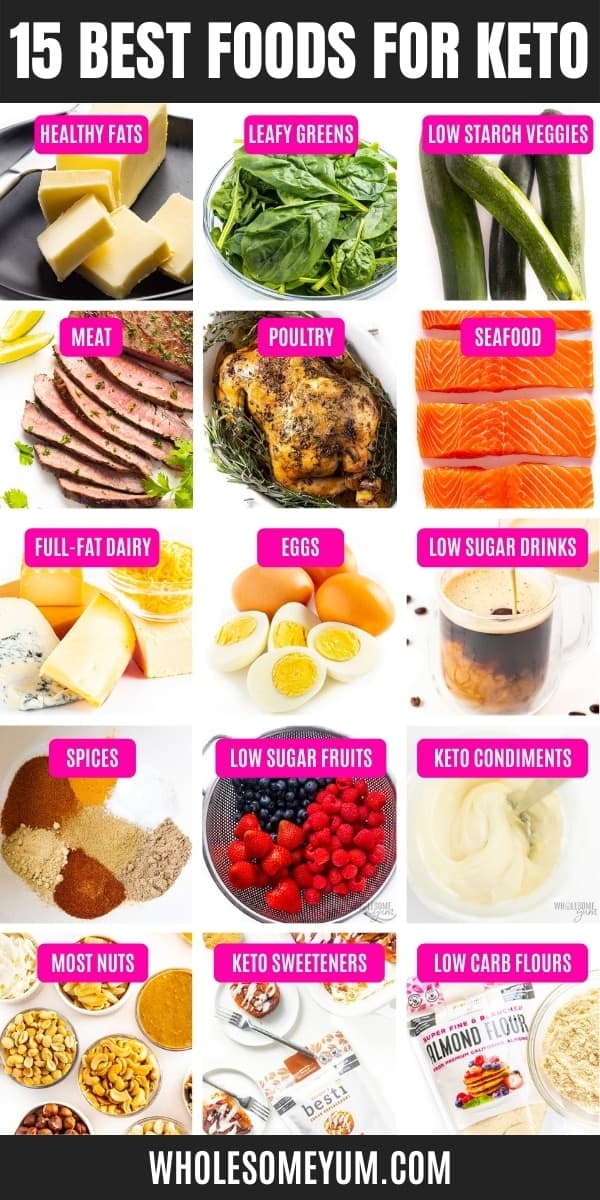
Foods to Avoid on a Low Carb Diet
Avoiding carbohydrates is probably the biggest adjustments for people starting a keto diet or low carb diet. Many of us were used to consuming carbs at every meal. Below is a list of foods to avoid:
- Grains – including wheat, bread, pasta, rice, oats, cereal, corn, etc.
- Sugar – including table sugar, candy, pastries, cakes, ice cream, chocolate, soda, juice, honey, maple syrup, etc.
- Starchy vegetables – including potatoes, sweet potatoes, parsnips, etc.
- Legumes – including beans, lentils, chickpeas, etc. (Peanuts are an exception in moderation.)
- High-sugar fruits – including bananas, pineapple, oranges, apples, grapes, etc.
- Low-fat dairy & milk – including all cow’s milk (except heavy cream is fine), low-fat cheese, etc.
- Seed & vegetable oils – especially margarine, canola oil, corn oil, grapeseed oil and soybean oil
- Processed “low carb” foods – this depends on ingredients, so read labels for hidden sugar, starch, and artificial ingredients
Get these out of your house if you can! If you have family members that are not on board, at least store these in a separate area from other foods to reduce temptation.
Also, always, always check labels for any food that has one. Avoid anything that has added sugar or starch as an ingredient, watching for different names like dextrose, maltodextrin, maple syrup, honey, corn syrup, cornstarch, potato flakes, etc. Sometimes you’ll be surprised where you might find added sugars.
Low Carb & Keto Diet Grocery List
The list above should give you an idea of the best and worst foods for a low carb diet. But if you’re starting out, it’s a good idea to know exactly what is included:
- Start with the complete low carb & keto food list – it has over 230 foods on it! It includes all the keto diet basics that you can and can’t eat, including carb counts. If you prefer to start with a shorter, less overwheming list, grab the keto grocery list for 1-2 trips to the store.
- Stock your pantry with all the dry keto basics and staples.
- Get discounts on keto products here – exclusive for Wholesome Yum readers!
- Check out the keto sweetener guide to help you choose the best ones and convert from one sweetener to another. You may or may not want to start with sweeteners right away, but it’s there when you’re ready.
- Buy keto ingredients here, including sweeteners, flours, syrups, baking mixes, and more.
Low Carb & Keto Recipes
If you are looking for low carb recipes or keto diet recipes, you’ve come to the right place! Every single recipe on Wholesome Yum is low carb and appropriate for the ketogenic diet.
Each recipe has 10 ingredients or less. I’m on a mission to show you that keto friendly recipes don’t have to be difficult, time consuming, or taste like “diet food”. I love sharing just how delicious and easy keto can be!
To get you started, here are a few of the most popular low carb keto recipes:
Another good place to start is with my library of keto dinner recipes, so you can start preparing ketogenic meals. The entire recipe index is at the button below.
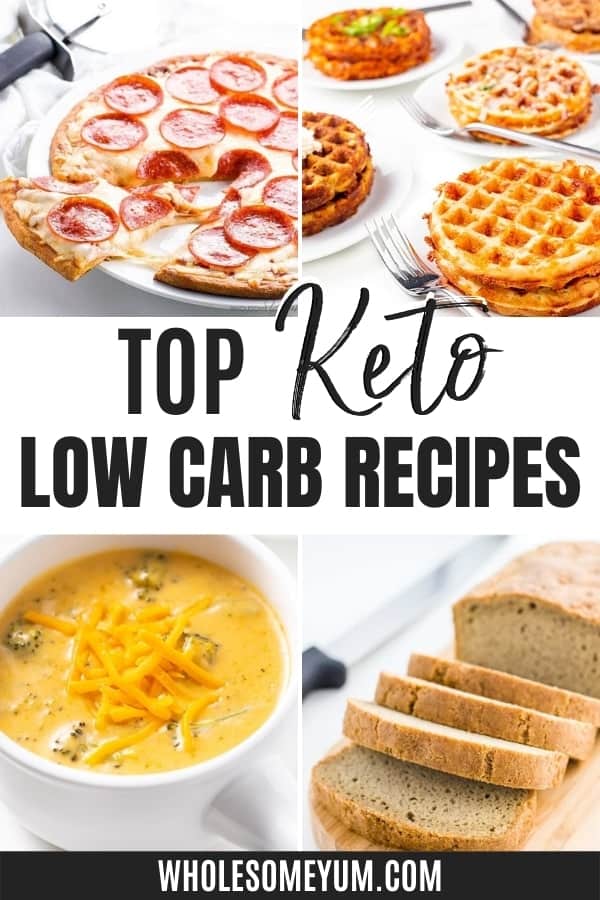
Keto Meal Plans
There are several excellent places where you can get a ketogenic meal plan:
- The Wholesome Yum App provides custom weekly keto meal plans that you can adjust to your preferences, builds an automatic grocery list for you, offers nearly 1,000 recipes, and has an easy macro tracker. Available on iPhone or Android.
- A FREE 7-Day Keto Meal Plan For Beginners is available right on my website. The recipes are simple keto diet basics that anyone can make.
- The Egg Fast Diet is a short-term ketogenic meal plan designed to break through a plateau on a keto diet.
- The Easy Keto Cookbook includes a sample week meal plan, plus 100 recipes for delicious ketogenic meals.
Get The Wholesome Yum App!
Make keto easy with customized keto meal plans, automatic macro tracking, auto generated grocery list, delicious low carb recipes, and more.
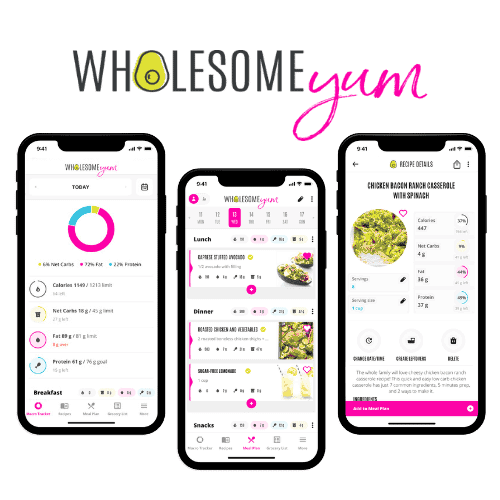
Get The Wholesome Yum App
Keto Diet Benefits
Following a ketogenic diet can have numerous benefits, including:
- Weight loss – Research shows that keto diets are more effective than low fat diets for long-term weight loss [*, *, *].
- Stable mood & energy levels – Reducing dietary carbohydrates is linked to better cognitive function [*, *] and possible reductions in depression and anxiety [*].
- Blood sugar control – Limiting carbs is shown to improve insulin sensitivity [*].
- Reduced cravings & appetite – Keto may positively affect your body’s hormones that signal hunger [*], and signal appetite suppression in the brain [*].
- Lower blood pressure – Some studies suggest that a low carb diet can be more effective at lowering blood pressure for obese patients than medication [*].
- Higher good cholesterol – In some studies, subjects following a keto diet experienced increases in HDL cholesterol levels [*].
- Skin improvements – Research suggests that keto can help improve skin conditions like acne, though more studies are needed [*].
- Digestive support – Some studies link keto with healthy gut bacteria [*].
- Possibly increased lifespan – Recent rodent studies show that a low carbohydrate diet improved longevity [*].
- Preservation of muscle mass – Loss of muscle is a common issue when losing weight, but a very low carbohydrate diet is more effective at preserving muscle mass compared to conventional diets [*].
Keto Diet Side Effects
Because a low carb diet (especially a keto diet plan!) reduces the amount of water you store, this can flush out electrolytes and make you feel sick — this is called the “keto flu”. These side effects of keto are temporary while you are adjusting to a ketogenic diet, but unpleasant. They can include headache, dizziness, fatigue, restlessness, brain fog, lack of motivation, nausea, insomnia, impaired coordination, sensitivity to heat, sugar cravings, muscle soreness or weakness, and stomach issues.
Fortunately, you can avoid or eliminate these side effects by salting your food liberally, drinking broth (especially bone broth), drinking my homemade electrolyte drink, and eating pickled vegetables. These keto diet basics are just as important as restricting carbs. Some people also choose to take supplements for electrolytes, but it’s best to first consult a doctor.
Check the complete guide to keto flu symptoms and remedies here so that you can avoid it!
Common Questions
- Is the keto diet healthy? If your keto diet is unbalanced, you may end up with deficiencies in electrolytes, B vitamins, iodine, iron, or other nutrients. However, a balanced keto diet with a focus on whole foods and healthy fats is a great, healthy choice.
- Is the keto diet safe? A keto diet is perfectly safe to try for generally healthy individuals. However, if you have any underlying health conditions, you should consult with a doctor before trying any new way of eating.
- Is the keto diet good for diabetics? Those with diabetes can benefit from a keto diet because it improves blood sugar and A1C levels [*]. However, it’s still important to work with a doctor when considering diet changes.
- How long does it take to enter ketosis? It usually takes about 3 days after starting a ketogenic diet to enter ketosis. However, it takes 3-4 weeks before you are “fat adapted” and burn fat efficiently. This is because the body takes a few days to burn through all the glycogen in your liver (your body stores extra glucose there and this gets depleted before you start producing ketones), and afterward, it takes some time for your body to adjust to using primarily fat for fuel.
- How to get enough fat on a keto diet? Eat foods naturally high in fat, such as eggs and fatty cuts of meat, or add dietary fats like grass fed butter and MCT oil to meals. You can also snack on fat bombs for a high-fat boost!
Conclusion: Is The Keto Diet For You?
The keto diet plan can be beneficial, enjoyable, and surprisingly easy to follow! But as always, always check with your doctor (preferably one that understands and supports a ketogenic lifestyle) before making a drastic change, especially if you take any medication. If you have the green light, use this guide for all the keto diet basics you need to get started.
How To Start A Keto Diet
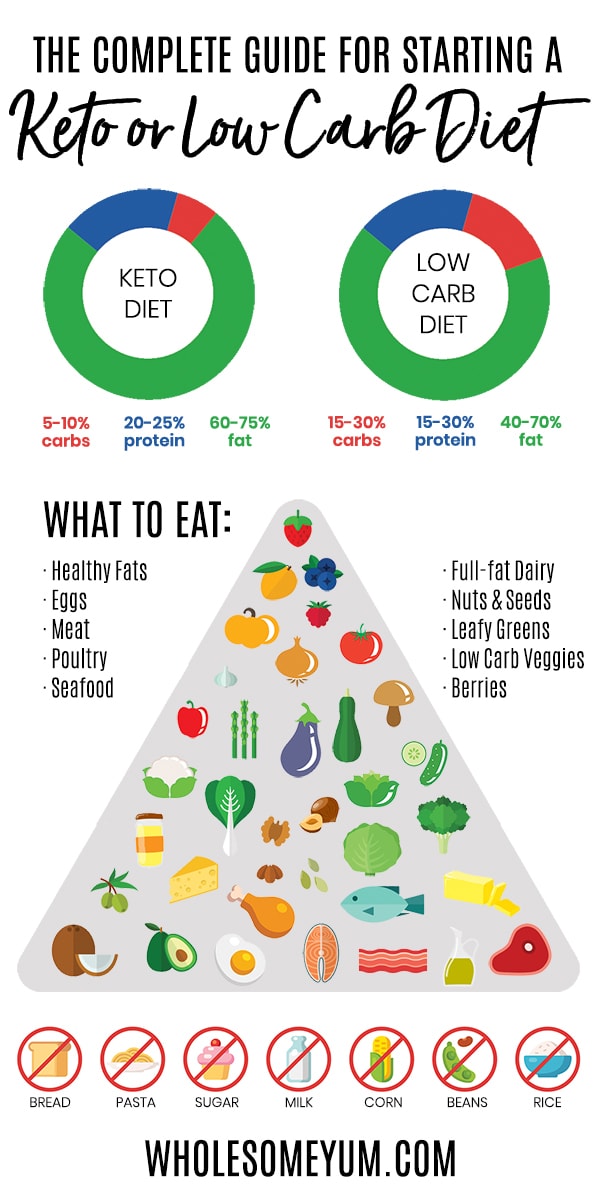
 My
My Shop
Shop Wholesome Yum
Wholesome Yum
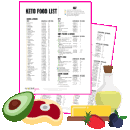
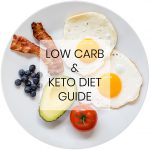

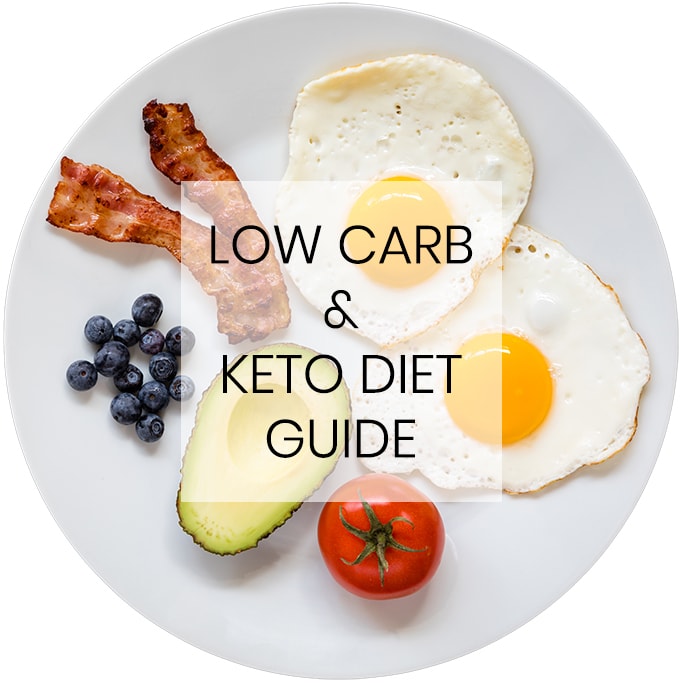





491 Comments
Gayla Essen
0The cheat sheets for this program are great and easy to follow! I have tried a few of the recipes and they are wonderful also. This takes the guess work out of how many carbs you are eating and helps make it easier to track your carb macros. Thank you for sharing your knowledge with everyone!
Maya | Wholesome Yum
0Thank you so much, Gayla – glad to hear you like the cheat sheets! For anyone else looking for them, you can find the keto cheat sheet system here.
Rita
0Hi, thank you for what you do! After losing 40 lbs on a supervised program, I am struggling with “gaining it back” as I haven’t had any transitional support. I felt so much better on a Keto-like plan but couldn’t afford to stay with my practitioner. I need help to make this a permanent life change. Regular routine & accountability are my goals.
Patrick Smith
0Looking forward to getting started on a Keto program and using these terrific resources to help me reach my goals.
Katie Catalano Simmons
0Hi! THANK YOU SO MUCH for these wonderful resources, and for generously posting them without cost. It’s not easy to begin a low-carb diet, or even start thinking about beginning and making the change, and your recipes are going to make it a LOT easier! I can’t wait to try some!
Thank you so much again, for making a huge positive impact on my life and the life of my family, as well as many, many others,
Katie
Diane
0Hey, there are some great recipes here 🙂 I really enjoy reading your blog, very informative. However, I have to admit I do find this load of information overwhelming sometimes… Especially if you don’t have much time. I personally prefer more casual and easy type of keto cooking.
Virgil
0I am interested in your offer of a free e-recipe. I see I’m required to subscribe. Are there costs involved?
Wholesome Yum M
0Hi Virgil, There are no subscription costs associated with the recipes on this website nor the newsletter. There is a paid meal plan membership and a few paid ebook offerings, but those are clearly marked with a dollar amount.
Lorraine Cain
0I am having a hard time keeping within my 1200 calorie a day and keeping the carbs low by recipes I see. How do you plan your meals to adjust to the fat, carb, protein percentages? I use My Fitness Pal and I always seem to come out at more than 5g of carbs.
Maya | Wholesome Yum
0Hi Lorraine, I create weekly meal plans to address exactly this. 🙂 The meal plans are available here if you want to try a free week. You might also find my guide for keto for beginners helpful.
Jill
0My Fitness Pal counts Carbs, not net carb (carbs less fiber). On the web version (not the app), You can set it up to see fiber, which you will then see on the app. You can then make the proper calculation. You may not really be over on the carbs if you subtract the fiber.
Tammy
0I am just getting started with this Keto thing. Tell me, what are fat bombs and why, when are they used?
Wholesome Yum M
0Hi Tammy, Fat bombs are a tool to help you adjust to becoming fat adapted and a treat to keep stored in your freezer. When transitioning to keto, you are teaching your body to burn fat instead of sugar in the body, so fat bombs can be used to help increase your fat intake. You do not need them, but they are commonly used in the keto diet.
Shelby
0Will be trying this out. Very nervous but helpful
Lina
0Thanks for the great advice, it’s constructive and made me inspired. I started a month ago and proud of myself.
Lee
0I’d like to try this
Sabra Taylor
0I don’t cook and realize that you want to sell cookbooks but anyone try this diet on a meal delivery plan?
Ash
0Excited to try this
Ana
0Hello. Will try this diet. Thank you for this.
Wendy Francis
0Hello Maya. At the end of December, 3 of my old school friends and I decided to try the keto diet as a way of losing weight fast. I went on to amazon and bought your book because I liked the look of your book cover! That was 2 weeks ago. Since then I have tried your wonderful recipes – I am astounded. The recipes are fantastic. I have a sweet tooth so your desserts have been a life changer and saver. I lost 6 pounds in the first week! However, this week I almost collapsed on a train – I think I was dehydrated and have since learned about ‘keto flu’ and paying more attention to my intake of water and salt. My friends have gone back to fat free diets but I want to continue with the keto approach as I feel so much better. Since I have been on the keto diet, my depression and anxiety has fallen away and I am waking up after a nights sleep, feeling so energised. I feel so much better in myself. I am pre – diabetic so it’s really important that I make a radical change. I feel I’ve finally found a wholesome food approach that works for me. I am drinking more water and eating lots more green veg! I just want to make sure I am doing things safely. So my question is – is it possible to go on a low carb diet and still lose weight? Because I am pre-diabetic, I don’t want to go into ketosis and lose weight to quickly but at the same time I would not like to plateau early when I have so much weight to lose (around 65 pounds). I would really appreciate your guidance if you have time. Best wishes
Wendy (from London)
Wholesome Yum M
0Hi Wendy, Congratulations on your keto journey! Yes, you can still lose weight while doing low carb. Keep your fluids up, salts up, and easy carry snacks on hand (Beef jerky, macadamias, parmesan cheese crackers, etc.) to prevent those moments of weakness. You will do great, please report back to us on how you are doing!
Erin
0Hi.
I was just wondering if you have any keto pie crust recipes? I tried to make chicken pies yesterday but my pastry kept crumbling and wouldn’t stay together.
Wholesome Yum M
0Hi erin, I have a couple of pie crust recipes for you to try! Here is a Coconut Flour Pie Crust, and here is an Almond Flour Pie Crust.
Phyllis M Smith
0Can’t wait to see where this diet journey takes me. Thank you for putting this on internet
Ada
0Hi, I’m Ada can’t wait to get started. My worry is won’t be able to get a lot of ingredients here in GH.
Wholesome Yum M
0Hi Ada, Welcome to the low carb lifestyle! Be sure to keep it simple with ingredients you do have available to you. Lots of great ingredients can be found online too.
Maartje
0Thank you
Mubashra Wahid
0Almost a month but only 3 kg lost
My intake
Carbs 14-17 g
Protein 52g
Fats 103 -107 g
My weight stuck
Wholesome Yum M
0Hi Mubashra, Have you used this online macro calculator to figure out your daily needs?
Gale
0So ready to get started. Just don’t know where to start.
Wholesome Yum M
0Hi Gale, Welcome to the keto and low carb lifestyle! After reading through the ‘How to Start’ guide, next go figure out your macro needs with our Macro Calculator . Best wishes on your keto journey!
Malissa
0Thank you so much. I have tried to find information on keto but did not know where to start, so thank you.
Diana J Boschetti
0Thank you for putting all this online!
Panda
0You’ve done great work here!
Leisha Storey
0Excited to try this!
Maryann
0Thank you for your help!
Kiana McAlpine
0Thank you so much!! This has motivated me so much to start my keto journey & eased the stress seeing all my food options !!!
Kari
0Looking forward to going keto!
Janice
0My biggest challenge on keto is how to figure what constitutes 70% fat for dinners. Protein and low carb veg are the easy part. Can I just eat a tablespoon or two of coconut oil with my meal to add the right amount of fat?
Maya | Wholesome Yum
0Hi Janice, Yes, you can do that if that’s easiest for you, but I find it’s much more tasty to just add some extra coconut oil while cooking your protein and low carb veggies. 🙂
Terry
0I am diabetic and have started a keto diet one month ago. I have been vegetarian my whole life, so this made thoughts of a keto diet a little more difficult. I started by reading Steven Cole’s Keto Vegetarian diet and have now been on it for a month with great results, to include lowering of my blood sugars. Do you have any other resources for a keto vegetarian, or recipe books that would be helpful? I have used Monks fruit/Erythritol for several years so am very comfortable with that as a sweetener.
Wholesome Yum M
0Hi Terry, I don’t know of any resources to suggest to you, but I do have a number of vegetarian recipes on my site. You can search for them under the “Recipes” drop down menu.
Linda
063 yrs old that cant lose weight. Need help with diet options with Keto Diet.
Dan d
0Hello ! I’ve calculated my macros it’s at 2845 calorie a day. Fat is 233g (74%); Protein is 161g(23%); net carbs 25g(4%)
I’m confused with the grams per day… am I suppose to eat 161g of protein(ground beef, chicken, shrimp) and how do I get to 233g of fat?
Do I consume cheese ?
Wholesome Yum M
0Hi Dan, Yes, consume 161g of protein each day, 25g or less of carbs each day, and use your fat as a lever. This means that the 233g is a maximum amount, and you want to stay under that number if your goal is weight loss. Consume enough fat throughout your day to keep satisfied, not leaving you feeling hungry or overfull.
Carol
0I am excited to begin
Zai
0I am excited to start my keto diet
Shirley Ridenour-Denton
0Just starting!!!!
Patty Booth
0I’m doing Keto and I found low carb whole wheat tortillas only 4 net carbs no sugar.Can I eat this ? I’m confused because is there certain foods you can’t eat because they are high in carbs or they just shouldn’t be eaten ?
Wholesome Yum A
0Hi Patty, some people do and others don’t. This would be a great question to bring to our low carb Facebook support group!
Valerie
0I’ve been low carb for years, I now have Multiple Sclerosis, so I was told to limit my saturated fat, I am actually gaining weight now. Any suggestions? I already don’t drink milk no sugar or chocolate, no bread but something is causing me to gain alot of weight.
Wholesome Yum A
0Hi Valerie, that would be a great question to share in our low carb Facebook support group!
Brycen Shumway
0I’ve been trying to figure out how to start a Keto Diet. I have been researching the health benefits and other stuff for a little over 2 months now. But I am what I affectionately call “Kitchen Illiterate”. I have no idea what I am doing in a kitchen. So this is very nerve racking new territory and will absolutely need a bit of hand-holding while getting started.
So I need some sort of “go buy this much of this” type of list. And it sounds like you provide that. But I have a severe allergy to Seafood. How do I adjust the list to fit this?
Wholesome Yum M
0Hi Brycen, It sounds like you would be interested in trying the Meal Plan membership. Get started here with a free week trial.
Kaz
0Hi,
Doctor advised me to do keto and I was baffled but thanks to your information I feel a lot better and able to do this. In Northern Ireland we are very behind with keto it is hard to get some of the products but I’m going to persevere with your help. Many thanks.
Kaz
John
0Can you follow the Low carb, Banting or Keto Diet while breast feeding? According to a Breastfeeding website you cannot. Please advise.
Wholesome Yum A
0Hi John, I’m not a medical professional and am not qualified to answer that, but there may be individuals in our low carb support group who can offer their experiences.
Nicole Swenson
0Really like your site. Just about to finish a round of HCG, trying to learn more about Keto as a possibility to keeping weight off and losing some more. Have done low carb before and it works for me, though was doing what I guess would be a ‘lazy’ version where I stuck to rules and food lists, but no counting or specific portion monitoring. IS THERE A SPECIFIC APP YOU WOULD RECOMMEND FOR TRACKING FOOD AND MACROS? Thanks!
Wholesome Yum M
0Hi Nicole, Most of the food tracking apps are very similar. The difference is really in the interface. I suggest you try a few free ones. Pick which is easiest for you to use, and then stick with it.
Debbie Shivers
0I really appreciate the information. I started the Keto diet 3 months ago. I have been able to lose 13 lbs. so far with the guidance of a friend. Struggling now with a plateau.
Wholesome Yum M
0Hi Debbie, Stick with it! If you find yourself stuck at the same weight for more than a month, then it’s time to re-calculate your macros.
Sven
0Wholesome Yum is literally the best weight loss community anywhere, I read it everyday and I’m also so grateful!
Christina
0Looking forward to being a member. Thanks
Carrie
0Ty
Gabby
0This post is great! Not many people take the time to explain everything but this is amazing.
Kathleen Guerra
0I am type 2 diabetic will keto harm me?
Wholesome Yum A
0Hi Kathleen, diabetics have used keto to manage their condition, but you should always consult your health care provider before trying it. You can also ask our facebook support group to hear how other type 2 diabetics have used keto to their advantage.
Elaine
0Very informative!
J
0The Keto resource is literally the best keto diet community anywhere. I read it every day, and I’m also so grateful I found it!
Mary
0Thanks for your help
I want to ask about the quantity of food like breakfast two egg plus half of avocado and two slice of bakin it’s enough
Lunch two to three piece of grilled or fried chicken with butter or a piece of steak with a bowl of salad is enough
Please advice
Wholesome Yum A
0Hi Mary, food needs vary from person to person depending on your macros and biology. Take a look at my low carb food list and macro calculator for more guidance, or get help from our low carb Facebook support group.